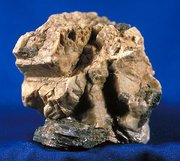Corundum
|
|
| Corundum | |
|---|---|
| General | |
| Category | Mineral |
| Chemical formula | aluminium oxide, Al2O3 |
| Identification | |
| Colour | Brown to grey, less often red, blue, white, yellow. |
| Crystal habit | Steep bipyramidal, tabular, prismaticl, rhombohedral crystals, massive or granular. |
| Crystal system | trigonal |
| Cleavage | None |
| Fracture | Conchoidal to uneven |
| Mohs Scale hardness | 9 |
| Luster | Adamantine to vitreous |
| Refractive index | 1.76-1.78, Biref 0.009 |
| Pleochroism | None |
| Streak | White |
| Specific gravity | 3.95-4.1 |
| Fusibility | ? |
| Solubility | ? |
| Major varieties | |
| Sapphire | Any color except red |
| Ruby | Red |
| Oriental topaz | Yellow |
| Emery | Granular |
Corundum is the crystalline form of aluminium oxide and one of the rock-forming minerals. Corundum is naturally clear, but can have different colors when impurities are added. Transparent specimens are used as gems, called ruby if red, while all other colors are called sapphire. The word corundum comes from the Hindi kurand.
The oxygen atoms in corundum are arranged in a hexagonal close-packing, with the smaller aluminium atoms occupying 2/3 of the octahedral gaps. The coordination of the atoms are thus 6:4, compared to 4:2 for quartz, which accounts for its greater hardness despite the Al-O bonds being less covalent.
Due to corundum's hardness (typically 9.0), it is commonly used in as an abrasive in machining, from huge machines to sandpaper. Emery is an impure and less abrasive variety, with a Mohs hardness of 8.0. Diamond is harder at 10.0, but typically much more expensive.da:Korund de:Korund fr:Corindon nl:Korund ja:コランダム pl:Korund pt:Corindon sv:Korund zh:剛玉

